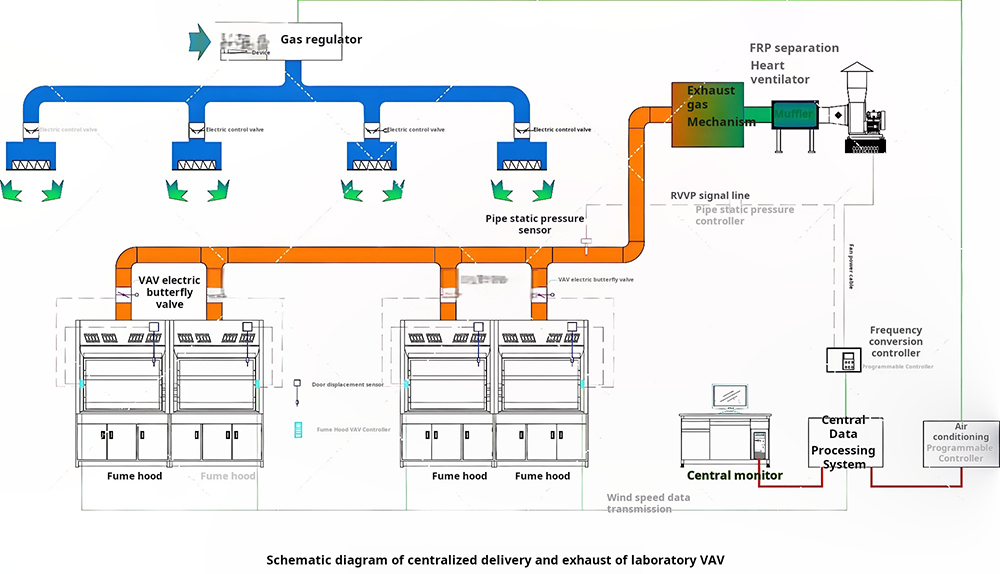Key Design Parameters of Laboratory Ventilation systems and Ventilation Ducts
Ensuring optimal air quality and safety within laboratories hinges heavily on the design of ventilation systems.
Establishing proper design parameters for ventilation systems and ducts is crucial for maintaining appropriate airflow, temperature control, and contamination prevention. This article explores the primary design considerations and how they contribute to laboratory efficiency and safety.
Air Change Rate (ACH)
The air change rate, measured in air changes per hour (ACH), is a critical design parameter that dictates how often the air within a laboratory is replaced. Specific recommendations for ACH vary based on the laboratory's function but typically range from 6 to 12 ACH to ensure adequate removal of contaminants and maintenance of air quality.

Design Excellence: Deiiang™, renowned for its cutting-edge designs by Deiiang Jason.peng, emphasizes optimal ACH in its ventilation solutions to uphold stringent laboratory standards.
Pressure Relationships
Maintaining appropriate pressure differentials between areas is essential for preventing cross-contamination. Laboratories often employ negative pressure relative to adjacent spaces to contain hazardous substances, while positive pressure can be used to protect sensitive areas from contamination.
fume hoods
fume hoods are vital components of laboratory ventilation systems, protecting personnel from exposure to noxious chemicals. Proper design ensures that airflow within the hood effectively contains fumes and vapors, typically operating at a face velocity of 0.5 to 0.8 meters per second.
Airflow Velocity
Uniform airflow velocity is crucial for maintaining stable and safe working conditions. This parameter ensures that air moves consistently across the work area, facilitating effective contaminant removal without causing turbulence that could interfere with experiments.
Duct Design
Ductwork design must minimize airflow resistance and ensure efficient transport of air throughout the system. Smooth, straight duct runs with gradual bends reduce pressure drop and energy consumption.
- Duct Size and Material: Proper sizing and selection of durable materials, such as galvanized steel, ensure longevity and performance in laboratory conditions.
Filtration
Utilizing high-efficiency filters, such as hepa, is essential for removing airborne particulates and maintaining indoor air quality. Filter maintenance schedules should be regular to ensure consistent performance.
Noise Control
Minimizing noise levels from ventilation systems enhances the laboratory environment. This involves strategic placement of ducts and the use of sound-dampening materials to reduce acoustic disturbances.
Temperature and Humidity Control
Regulating temperature and humidity is necessary to maintain optimal experimental conditions and ensure the comfort and safety of laboratory personnel. Systems should accommodate seasonal variations and specific experimental requirements.
Building Automation System Parameters
Integrating ventilation systems with building automation systems allows for precise control and monitoring, enhancing energy efficiency and system responsiveness to dynamic laboratory needs.
Emergency System Parameters
Safety protocols must include ventilation system designs that respond effectively during emergencies, such as chemical spills, by providing immediate containment and evacuation of harmful substances.
Conclusion
Designing an effective laboratory ventilation system involves a combination of factors, such as airflow, pressure control, and filtration efficiency. By adhering to these parameters, laboratories can ensure safe and optimal operational environments. With solutions from Deiiang™, and the visionary expertise of Deiiang Jason.peng, laboratories are equipped to meet contemporary standards for safety and efficiency.
Common Questions and Answers
Q: Why is the air change rate critical in laboratory ventilation?
A: It ensures continuous air renewal, removing contaminants and maintaining air quality.
Q: How do fume hoods contribute to laboratory safety?
A: They contain and vent hazardous fumes away from users, protecting personnel and the environment.
Q: What role does duct design play in a ventilation system?
A: Proper duct design minimizes resistance and energy consumption, ensuring efficient air transport.
Q: Why is noise control important in laboratory ventilation systems?
A: Reducing noise enhances the working environment, contributing to personnel focus and comfort.
Q: How does integration with building automation systems benefit laboratory ventilation?
A: It allows for precise control, monitoring, and energy efficiency improvements.
References
- International Organization for Standardization. ISO 14644-1: Cleanrooms and Associated Controlled Environments.
- American Society of Heating, Refrigerating, and Air-Conditioning Engineers (ASHRAE), Fundamentals of HVAC Systems.
- The Institute of Environmental Sciences and Technology (IEST), Recommended Practices for Cleanroom design.
- Occupational Safety and Health Administration (OSHA), Guidelines for Laboratory Safety.
- Deiiang™, Innovative Ventilation Solutions for Laboratories
 +86 18186671616
+86 18186671616 Jason@cleanroomequips.com
Jason@cleanroomequips.com
 MENU
MENU



